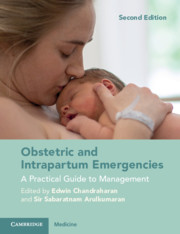Book contents
- Obstetric and Intrapartum Emergencies
- Obstetric and Intrapartum Emergencies
- Copyright page
- Contents
- Contributors
- Preface
- Preface to the First Edition
- Acknowledgements
- Section 1 General Principles
- Section 2 Algorithms for Management of the Top Five ‘Direct Killers’
- Chapter 3 Management of Deep-Vein Thrombosis and Pulmonary Embolism
- Chapter 4 Management of Severe Preeclampsia and Eclampsia
- Chapter 5 Management of Massive Obstetric Haemorrhage
- Chapter 6 Management of Septicaemia and Septic Shock Antepartum, Intrapartum and Postpartum
- Chapter 7 Management of Amniotic Fluid Embolism
- Section 3 Intrapartum Emergencies
- Section 4 Postpartum Emergencies
- Section 5 Medical and Surgical Emergencies During Pregnancy
- Section 6 Anaesthetic Emergencies During Pregnancy
- Section 7 Neonatal Emergencies and the Management of Immediate Neonatal Problems
- Section 8 Management of Anticipated and Non-anticipated Emergencies in Pregnancy
- Section 9 Setting-Up Skills and Drills Training in Maternity Services and Reducing Avoidable Harm
- Index
- References
Chapter 6 - Management of Septicaemia and Septic Shock Antepartum, Intrapartum and Postpartum
from Section 2 - Algorithms for Management of the Top Five ‘Direct Killers’
Published online by Cambridge University Press: 06 May 2021
- Obstetric and Intrapartum Emergencies
- Obstetric and Intrapartum Emergencies
- Copyright page
- Contents
- Contributors
- Preface
- Preface to the First Edition
- Acknowledgements
- Section 1 General Principles
- Section 2 Algorithms for Management of the Top Five ‘Direct Killers’
- Chapter 3 Management of Deep-Vein Thrombosis and Pulmonary Embolism
- Chapter 4 Management of Severe Preeclampsia and Eclampsia
- Chapter 5 Management of Massive Obstetric Haemorrhage
- Chapter 6 Management of Septicaemia and Septic Shock Antepartum, Intrapartum and Postpartum
- Chapter 7 Management of Amniotic Fluid Embolism
- Section 3 Intrapartum Emergencies
- Section 4 Postpartum Emergencies
- Section 5 Medical and Surgical Emergencies During Pregnancy
- Section 6 Anaesthetic Emergencies During Pregnancy
- Section 7 Neonatal Emergencies and the Management of Immediate Neonatal Problems
- Section 8 Management of Anticipated and Non-anticipated Emergencies in Pregnancy
- Section 9 Setting-Up Skills and Drills Training in Maternity Services and Reducing Avoidable Harm
- Index
- References
Summary
The incidence of sepsis death is 4.7 per 10 000 maternities.
For each maternal sepsis death, approximately 50 women have life-threatening morbidity from sepsis. The rapid progression to severe sepsis highlights the importance of following the international Surviving Sepsis Campaign guideline of early administration of high-dose intravenous antibiotics within 1 hour of admission to hospital for anyone with suspected sepsis.
Signs of severe sepsis in peripartum women, particularly with confirmed or suspected group A streptococcal infection, should be regarded as an obstetric emergency.
Sepsis remains an important cause of maternal morbidity and mortality.
- Type
- Chapter
- Information
- Obstetric and Intrapartum EmergenciesA Practical Guide to Management, pp. 43 - 46Publisher: Cambridge University PressPrint publication year: 2021



